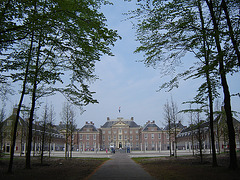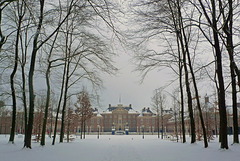
Apeldoorn
Nederland - Apeldoorn, Paleis Het Loo
| |
|
|
|
‘Paleis Het Loo’ (Palace Het Loo) was built in 1686 by Stadtholder William III and used for almost 300 years as a (summer) palace by members of the Dutch Royal family. Queen Wilhelmina lived here till the year of 1972. After a huge restoration palace and gardens are back in their original state. Since the year of 1984 ‘Paleis Het Loo’ is a national museum and open for public.
Nederland - Apeldoorn, Paleis Het Loo
Nederland - Apeldoorn, Paleis Het Loo
Nederland - Apeldoorn, Paleis Het Loo
| |
|
|
|
Paleis Het Loo (Het LooPalace) was built in 1686 for Stadtholder William III and his wife queen Mary. It was used for almost 300 years as a (summer) palace by members of the Dutch Royal family. Queen Wilhelmina lived here till the year of 1972. After a huge restoration palace and gardens are back in their original state. Since the year of 1984 Paleis Het Loo is a national museum and open for public.
In 2018 (again) major restoration work was necessary to ensure that the collection and the palace remain in good condition. Inside the palace was refurbished and outside the forecourt fully changed: instead of grass and a fountain there is now a wonderful water bassin, reflecting the palace. Surely the most striking thing is the expansion of the exhibition spaces underneath the new forecourt. One of them now houses the permanent presentation about the House of Orange-Nassau from Prince Willen van Oranje (1533 - 1584) till the present heir Princess Amalia (born 2003). This underground expansion of 5.000 m2 was officially opened April 2023.
Nederland - Apeldoorn, Paleis Het Loo
Nederland – Apeldoorn, Paleis Het Loo tuin
| |
|
|
|
Paleis Het Loo (Het Loo Palace) was built in 1686 for stadtholder Willem III and his wife queen Mary of England. The palace was the summer residence of the Dutch stadtholders, kings and queens from 1686 to 1975. Princess Margriet last inhabited parts of the palace.
Het Loo was planned and created as a combination of a palace and baroque garden. This garden - designed by Claude Desgotz - was more than a royal hobby; it was a symbol for the position and power of the royal couple. All elements in the garden, such as the garden statues and the fountains, fit within this symbolic meaning. Flowers and plants play are important elements in the gardens of Paleis Het Loo . In the 17th century, a garden with exotic - and therefore expensive - flowers and plants meant that the owner had the wealth and contacts to have such a garden laid out and maintained.
In the 18th century the baroque garden was replaced by an English landscape garden. However, the original gardens were restored from 1980 to 1984, when the palace and gardens became a national museum. The starting point was preserved design drawings, as well as excavations on site. Some of the plants at Het Loo change every year, both in the spring and in the summer. The aim is to achieve the most accurate possible reconstruction of the original garden.
(During our last visit the garden was decorated with four monumental contemporary art works - 'The Garden of Earthly Worries’ - designed by the Polish-American architect Daniel Libeskind. It is the first time that contemporary art is on show in the garden of Paleis Het Loo .)
Nederland - Apeldoorn, Kasteel Het Oude Loo
Nederland - Apeldoorn, Het Oude Loo
| |
|
|
|
Kasteel Het Oude Loo (Castle Het Oude Loo) is dating back to the early 15th century when it was a farm, which later was fortified. When it came into the possession of the Bentinck family the moated castle as we see it today was built and enlarged between 1538 and 1540. In those days it was used as a hunting lodge by Karel, Duke of Gelre.
In 1684 Prince Willem III van Oranje, Stadtholder of Holland and Zeeland acquired the castle. He also used it as a hunting lodge. Soon the castle became too small for his hunting parties and he built Paleis Het Loo (the Loo Palace) in 1686-88.
In 1795, when the French occupied Holland, the castle was used as a military hospital and the castle fell into neglect. In 1806 Napoleon Bonaparte appointed his brother Louis Napoleon as King of The Netherlands. Louis resided in the castle during summers. He filled up the moat around the castle.
In 1904 Queen Wilhelmina of the Netherlands ordered the restoration of the castle. This was done by the famous Dutch architect Cuypers. In the 1950's and 1960's other restoration works were carried out. Since 1968 the castle has been owned by the Dutch state. In 1973 it became a national heritage site.
Kasteel Het Oude Loo - located within the Paleispark - is nowadays used by the Dutch royal family as country house and guest residence. The castle itself is not open for the public, but the surrounding fenced garden/park can be visited during April and May.
Nederland - Apeldoorn, Paleispark
| |
|
|
|
The Paleispark (Palace park) is a part of Kroondomein Het Loo (Het Loo Royal Estate). With an area of 650 hectare the park is ideal for strolling and walking. It lies adjacent to Paleis Het Loo and around Kasteel Het Loo . Traditionally this park (PiP 5 and 6) was for the relaxation of the royal residents of and their guests.
The origins of the palace park can be traced back to stadtholder Willem III, who purchased hunting lodge Het Oude Loo in 1684 together with 200 hectare land. Het Loo Royal Estate was also very important for Queen Wilhelmina. She purchased many acres of land and donated this to the State in 1959, retaining the rights of usage for the reigning monarch. This explains the name for the whole area: Kroondomein Het Loo (Het Loo Royal Estate).
The palace park is only a small part of Het Loo Royal Estate. The park features ponds (PiP1), a tea pavilion (main image and PiP2), which was often used by Queen Wilhelmina, a bath-house, a royal horse cemetery (PiP3), an old shooting range, a hunting lodge (PiP4) and several follies. The park is open - against a small fee - the whole year round, the fenced part around Het Oude Loo is open for visitors only during the months April and May.
Nederland - Apeldoorn, Kroondomein/Kathedraal
| |
|
|
|
The Kathedraal (Cathedral) is a work of art by Marinus Boezem. It was donated to the Kroondomein Het Loo (Het Loo Royal Estate) by the then Queen Beatrix on the occasion of her 60th birthday to underline the connection of the House of Orange with this nature reserve. The artwork was unveiled in 1999.
The work of art consists of 40 bronze tree trunks on a concrete foundation. They have been placed exactly according to the floor plan of Reims Cathedral, on a surface area of 125 by 35 meters. The stumps are casts of a by the artist modeled clay model.
The Kathedraal is one of the most hidden and inaccessible works of art in the Netherlands. Located in the middle of the woods - not signposted - of the Kroondomein Het Loo it can only be reached on foot or by bicycle.
Nederland - Apeldoorn, Kroondomein
| |
|
|
|
Puddle of rain water, completely covered by green common duckweed (??).
Took this picture along the Wieselseweg in the ‘Kroondomein Het Loo’ (Royal Domain Het Loo) nearby the so called ‘Kathedraaal’; an artwork of 40 bronze tree-stumps.
Nederland - Apeldoorn, Park Berg & Bos
| |
|
|
|
At the end of the 19th century large pieces of the estate Berg en Bosch were bought by the Belgian merchant J.C. Wils (there is still a J.C Wilslaan in Apeldoorn). He had conifers planted, which were used for mining. After his death, the municipality of Apeldoorn bought the site. Part of it was used for the construction of a residential area; the other part remained available as a walking forest for city residents and tourists.
In the twenties of the 20th century the first initiatives for Park Berg & Bos were made. During the crisis years (1934) the large pond was dug by hand by unemployed workers from the municipality as a procuring of employment project.
The 250-hectare park adjacent to “Het Loo Royal Estate” offers a mixture of plants, trees and animals from the Veluwe. Plant borders close to the entrance define the image and paths around the pond invite for a walk. The further you get, the more the Park Berg & Bos, will resemble the surrounding nature of the Veluwe with its extensive forests and small heathlands.
Since 1971 part of the park has been used by the famous Apenheul , a zoo with free roaming primates. Except Apenheul the park can be visited for free.
Nederland - Apeldoorn, Man met Twee Hoeden
| |
|
|
|
Apeldoorn: 'Man met Twee Hoeden' / 'Man With Two Hats'.
This monument marks the 55th anniversary of the liberation of the Netherlands and serves as a lasting reminder of the role of Canadian soldiers in securing that freedom.
The statue was unveiled in the year 2000 by Her Royal Highness Princess Margriet, who lives in Apeldoorn.
The monument symbolizes the historic bonds between Canada and the Netherlands. It is a mysterious figure, which seems to be waving both hands with a hat in each one.
Nederland - Apeldoorn, Grote Kerk
| |
|
|
|
The 'Grote Kerk' - This very colourful stained-glass window is a present from the citizens and employers of Apeldoorn to (former) Queen Beatrix of the Netherlands as a tribute for the 25 years of being queen of the Netherlands.
Nederland - Apeldoorn, Mariakerk
| |
|
|
|
'Onze Lieve Vrouwe ten Hemelopneming' (Our Lady of the Assumption), commonly called Mariakerk with its stunning interior of brick ceilings, wall paintings, Stations of the Cross, altars and stained-glass windows.
Nederland - Apeldoorn, De Parken
| |
|
|
|
De Parken is a neighbourhood of the city of Apeldoorn. This residential area arose between the old village and the small settlement around Het Loo Palace. The neighborhood is named after the more or less contiguous parks: Oranjepark, Wilhelminapark, Prinsenpark and Verzetsstrijderspark.
In the 19th century the area had three estates: De Pasch, De Vlijt and Sophia's Hoeve. From 1874 until the beginning of the 20th century, these were acquired by project developers. They built the public parks and roads and sold plots of land for the construction of villas. Most of the houses were built between 1880 and 1920.
Initially, the neighbourhood was very popular with wealthy pensioners, manufacturers and senior civil servants from the west of the Netherlands. Even today the Parkenbuurt is a very popular residential area, because of its location close to the center of Apeldoorn, but also because of the green park-like surroundings, with relatively large gardens and tree-lined streets.
Pictures:
Prinsenpark: PiP - Monument “Het Apeldoornse Bosch” by Ralph Prins
( www.apeldoornschebosch.nl/in-the-vicinity/monument-prinsenpark-apeldoorn )
Oranjepark: PiP - Central war monument “De man met de vlag” by Cor Hund
Verzetsstrijderspark: PiP - Artwork “Constructie 3” by Cyril Lixenberg
Nederland - Apeldoorn, Oranjepark
Nederland - Apeldoorn, Oranjepark
Jump to top
RSS feed- Latest items - Subscribe to the latest items added to this album
- ipernity © 2007-2024
- Help & Contact
|
Club news
|
About ipernity
|
History |
ipernity Club & Prices |
Guide of good conduct
Donate | Group guidelines | Privacy policy | Terms of use | Statutes | In memoria -
Facebook
Twitter


















